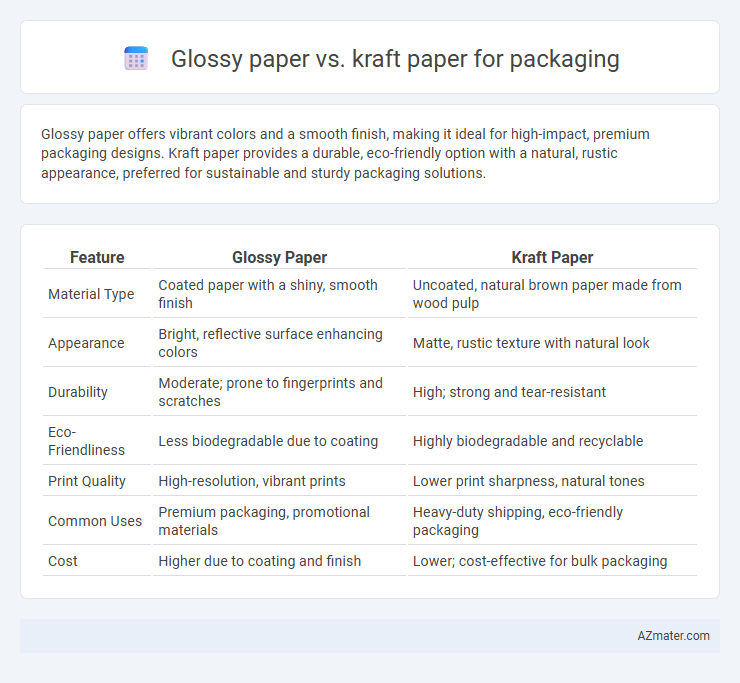Glossy paper offers vibrant colors and a smooth finish, making it ideal for high-impact, premium packaging designs. Kraft paper provides a durable, eco-friendly option with a natural, rustic appearance, preferred for sustainable and sturdy packaging solutions.
Table of Comparison
| Feature | Glossy Paper | Kraft Paper |
|---|---|---|
| Material Type | Coated paper with a shiny, smooth finish | Uncoated, natural brown paper made from wood pulp |
| Appearance | Bright, reflective surface enhancing colors | Matte, rustic texture with natural look |
| Durability | Moderate; prone to fingerprints and scratches | High; strong and tear-resistant |
| Eco-Friendliness | Less biodegradable due to coating | Highly biodegradable and recyclable |
| Print Quality | High-resolution, vibrant prints | Lower print sharpness, natural tones |
| Common Uses | Premium packaging, promotional materials | Heavy-duty shipping, eco-friendly packaging |
| Cost | Higher due to coating and finish | Lower; cost-effective for bulk packaging |
Introduction to Packaging Materials
Glossy paper and Kraft paper serve distinct roles in packaging due to their material properties and aesthetic appeal. Glossy paper offers a smooth, reflective surface ideal for high-quality print graphics, enhancing brand visibility and product appeal. Kraft paper provides strength, durability, and eco-friendliness with its coarse texture and natural brown color, making it preferred for sustainable packaging solutions.
What Is Glossy Paper?
Glossy paper is a smooth, shiny paper type coated with a layer of clay or polymers to enhance brightness and color vibrancy, making it ideal for high-quality packaging with vivid graphics and images. It offers excellent print sharpness and water resistance, often used for premium product packaging and promotional materials. Compared to kraft paper, glossy paper provides a more polished and eye-catching finish, though it is less eco-friendly and less durable under rough handling.
What Is Kraft Paper?
Kraft paper is a durable, coarse-textured paper made from chemical pulp through the kraft process, known for its high tear resistance and strength, making it ideal for sustainable packaging solutions. Unlike glossy paper, which features a shiny, smooth surface achieved by coating with clay or polymers for enhanced visual appeal, kraft paper offers an uncoated, natural brown finish emphasizing eco-friendliness and recyclability. Its fibers are less processed, contributing to a more robust structure suitable for heavy-duty packaging, often preferred in industries prioritizing environmental impact and product protection.
Appearance and Aesthetic Differences
Glossy paper offers a smooth, shiny finish that enhances color vibrancy and creates a premium, eye-catching look, ideal for luxury packaging and product displays. Kraft paper provides a rustic, matte texture with a natural brown tone that emphasizes eco-friendliness and artisanal appeal. The contrasting aesthetics--glossy paper's sleek polish versus kraft paper's organic, textured surface--cater to different brand identities and consumer perceptions.
Durability and Strength Comparison
Glossy paper offers a smooth, coated surface that enhances visual appeal but generally lacks the durability and tear resistance of Kraft paper, which is known for its robust fibers and natural strength, making it ideal for heavy-duty packaging. Kraft paper's high tensile strength and resistance to punctures provide superior protection during shipping and handling, while glossy paper is more prone to creasing and damage under stress. For packaging requiring durability and strength, Kraft paper outperforms glossy paper by maintaining integrity and safeguarding contents more effectively.
Environmental Impact: Glossy vs Kraft
Kraft paper is more environmentally friendly than glossy paper due to its biodegradable nature and lower energy consumption during production. Glossy paper typically involves chemical coatings and plastic lamination, making it less recyclable and contributing to higher landfill waste. Choosing kraft paper packaging supports sustainable practices and reduces carbon footprint in the supply chain.
Cost and Economic Considerations
Glossy paper typically incurs higher costs due to its coated finish and enhanced visual appeal, making it suitable for premium packaging that demands a striking presentation. Kraft paper offers a more economical option with its uncoated, natural brown texture, ideal for businesses prioritizing sustainability and budget efficiency. Choosing between glossy and kraft paper for packaging depends on balancing desired aesthetics against cost constraints and brand positioning.
Print Quality and Customization Options
Glossy paper offers superior print quality with vibrant colors and sharp details, making it ideal for high-end packaging that demands visual impact, while kraft paper provides a natural, textured surface that enhances rustic or eco-friendly branding but limits color vibrancy. Customization on glossy paper includes a wide range of finishes, coatings, and full-color printing options, whereas kraft paper customization often involves spot colors, embossing, and eco-conscious inks that align with sustainable packaging trends. Brands seeking premium, eye-catching designs typically choose glossy paper, whereas those prioritizing sustainability and a natural aesthetic lean towards kraft paper packaging.
Suitability for Different Products
Glossy paper offers a sleek, polished finish ideal for premium products like cosmetics and electronics, enhancing visual appeal and attracting consumer attention. Kraft paper provides a natural, rustic look, making it suitable for organic foods, handmade goods, and eco-friendly brands seeking sustainable packaging options. Choosing between glossy and kraft paper depends on product positioning, marketing goals, and the desired environmental impact of the packaging.
Choosing the Right Paper for Your Packaging Needs
Glossy paper offers a smooth, shiny finish that enhances color vibrancy and visual appeal, making it ideal for high-end product packaging and marketing materials requiring premium presentation. Kraft paper provides durability, a natural rustic look, and eco-friendly qualities, perfect for sustainable packaging solutions and products emphasizing environmental responsibility. Selecting the right paper depends on your brand image, product protection requirements, and environmental goals to ensure effective packaging performance and customer engagement.

Infographic: Glossy paper vs Kraft paper for Packaging
 azmater.com
azmater.com